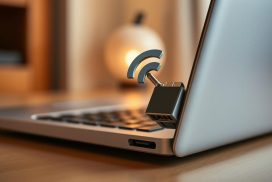Troubleshooting Guide: Fixing Non-Responsive Keyboard Keys on a Laptop
Having trouble with your laptop keyboard is really annoying. This keyboard repair guide will show you how to tackle laptop keyboard issues. You’ll learn about common problems and how to fix keys that don’t work. We’ll discuss simple cleaning methods and software checks. This guide has all the details for fixing your laptop keyboard.
Understanding Non-Responsive Keyboard Keys
Keys that don’t respond can really slow you down and annoy you. Knowing why keys stop working helps fix them quicker. Problems could be due to the keyboard’s hardware or its software.
Common Causes of Keyboard Issues
Key troubles often come from a few usual causes. Here are some:
- Connections that aren’t secure, like when cables are not fully plugged in, make it hard for the keyboard to work with your computer.
- When drivers aren’t right because they’re old or broken, your keyboard might not work at all. It’s like it’s disconnected.
- Sometimes the main board inside the computer, the motherboard, might not connect well. This can stop keys from working.
- Knowing these causes of keyboard problems helps find a way to fix them.
Impact of Dirt and Spills on Keyboard Functionality
Keeping your keyboard clean is key for it to work well. Spills can make keys stick or not work. Dirt makes matters worse:
- When keys get stuck, typing becomes hard. It can keep going wrong, making it stressful.
- The keyboard’s performance drops if dirt builds up under the keys over time.
Regularly cleaning your laptop keyboard makes it work better and last longer. It’s very important for laptop keyboards where dirt hides easily. Knowing how to keep your keyboard clean is crucial. Keeping up with cleaning prevents dirt build-up and keyboard damage.
If you need more help with keys that won’t respond, look at this detailed guide. It has specific advice for laptops.
How to Diagnose the Problem
Figuring out what’s wrong with your laptop keyboard needs a step-by-step method. Start by booting into Safe Mode to see if the problem is due to hardware or software. If your keyboard works better in this basic mode, it might mean the trouble is caused by something else.
Booting into Safe Mode
Entering Safe Mode can really help find out what’s wrong with your keyboard. It lets you check how well the keyboard works when other software isn’t in the way. If your keyboard does okay in Safe Mode, chances are the issue is with software or drivers. But if problems keep up, it’s likely a hardware thing.
Checking for Hardware Diagnostics
It’s vital to do hardware diagnostics to spot what’s messing with your keyboard. You can go into the BIOS menu as your computer starts to test the keyboard without the operating system affecting it. If the keyboard largely works there, the problem could be software-related. But if the keys still don’t work right, you might be looking at hardware trouble.
Remember, signs like dirt or keys that don’t move smoothly often mean hardware issues. This clue can help point you in the right direction when trying to fix the problem.
How to Fix Keyboard Keys Not Working Laptop
Keyboard problems often start with basic steps. A simple laptop reboot can solve temporary software issues. This lets the keyboard work properly again. Restarting clears unneeded processes, possibly making the keyboard responsive.
Rebooting Your Laptop
Rebooting refreshes the system, fixing software issues affecting keyboards. This easy fix is sometimes missed, but can revive unresponsive keys. If rebooting doesn’t help, it’s time to look deeper.
Inspecting for Driver Issues
Outdated or corrupt keyboard drivers often cause issues. Updating drivers via Device Manager is recommended. Sometimes, reinstalling keyboard drivers is necessary for good device communication. Keeping drivers up-to-date is key to fixing non-working keys.
Resolving Software Glitches
Incorrect settings or system updates can disrupt keyboards. Adjusting sensitivity settings can solve unexpected problems. Turning off Sticky Keys might also get things back to normal. Regular checks and tweaks can prevent typing problems.
For detailed solutions, check out this guide. It offers more tips on fixing keyboard issues.
Cleaning Your Laptop Keyboard
Keeping your laptop keyboard clean is key for it to work well and last longer. Cleaning it regularly stops dirt and debris from building up. This can stop the keyboard from working right. Using good cleaning methods makes sure it looks clean and avoids damage over time.
Effective Cleaning Techniques
Using the right cleaning methods keeps your keyboard working well. Here are some tips to follow:
- Turn off and unplug your laptop before you start cleaning. This makes it safe to clean the keyboard.
- Use compressed air to get rid of debris between the keys.
- Try a soft paintbrush or cotton swabs with isopropyl alcohol for tough stains.
- If you have a mechanical keyboard, take off the keycaps one at a time. Wash them in warm soapy water, then put them back when dry.
- Let your laptop dry for 2-4 hours after cleaning, especially if you used any liquid.
Avoiding Damage During Cleaning
Follow these tips to avoid damaging your keyboard while cleaning:
- Don’t use disinfecting wipes or bleach-based products as they can harm the keys’ coating.
- Avoid eating or drinking over your keyboard to reduce spill risks.
- Wipe the keys with a damp cloth carefully. Make sure no moisture gets into the electronics.
- If keys get sticky, clean them again with a cotton swab and isopropyl alcohol to remove any residue.
- Cleaning under the keys might be hard as not all laptops have removable keys. Do it carefully if needed.
Using these cleaning methods can help protect your laptop. This makes sure you have a good user experience. Regular care stops dirt build-up. This lets your laptop keyboard work well always.
Addressing Hardware Issues
Many problems with laptops come from hardware, like keys that won’t respond. A common issue is the keyboard’s connection to the motherboard being loose. Fixing this often means reattaching the ribbon cable carefully. It’s important to follow the maker’s guide closely to avoid harming the laptop’s insides.
Reconnecting the Keyboard Ribbon Cable
Reconnecting the ribbon cable is simple but crucial for fixing the keyboard. First, make sure the laptop is off and not plugged in. Then, open the back to get to the parts inside. You might need to gently move things to find the keyboard’s ribbon cable. Once found, check that it’s firmly connected to the motherboard. This can make the keyboard work much better.
Considering Professional Repair Services
When fixing it yourself doesn’t work, it’s wise to consider professional help. Experts have the tools and knowledge to solve keyboard problems. They can find and fix issues that you might miss. Using a pro can fix the keyboard right, without damaging other parts. For tough problems, like damaged parts, going to pros like GreenIT in Nass Co Kildare is smart. Knowing when to get help saves time and avoids mistakes in fixing laptops.
Conclusion
Fixing a laptop keyboard that doesn’t respond might need various steps. This includes simple cleaning or taking it for expert fixes. When you understand the usual problems like dirt or software issues, you can tackle them better. It boosts your confidence in keeping your keyboard in good shape.
Different methods can help fix your keyboard. You might need to clean it, check software drivers, or get help from professionals. While some problems can be solved with a quick clean or adjustment, others might need more work. It’s important to know that many keyboard issues are due to hardware failures.
Looking after your laptop keyboard can make it last longer and work better. To sum up, regular care and quick fixes can solve many problems. This approach helps you deal with keyboard issues in a confident and effective way.
FAQ
What are the common causes of laptop keyboard issues?
Laptop keyboard issues often arise from hardware failures, like a broken motherboard. Driver errors and connectivity problems also play a part. Plus, if your keyboard is dirty, it might not work well.
How can dirt and spills affect keyboard functionality?
Dirt and spills are bad news for keyboards. They can make keys stick or even stop working by damaging the electronics underneath. It’s crucial to keep your keyboard clean to avoid these issues.
What should I do first when my keyboard stops working?
If your keyboard stops working, try rebooting your laptop. This simple action can fix temporary glitches. It’s an easy first step to get your keyboard working again.
How do I boot into Safe Mode to diagnose keyboard issues?
Boot into Safe Mode by restarting your laptop and hitting F8 or Shift + F8 as it starts. In Safe Mode, you can check if your keyboard’s problems are due to software or hardware.
How can I fix keyboard driver problems?
Updating or reinstalling keyboard drivers might fix the issue. Use the Device Manager to keep drivers up to date. This step can solve many keyboard problems.
What are effective cleaning techniques for a laptop keyboard?
To clean your keyboard, use compressed air to remove dust and debris. Gently wipe the keys with a soft cloth. Sometimes, turning the laptop upside down helps remove particles. Regular cleaning enhances your keyboard’s life.
How can I avoid damaging my laptop keyboard during cleaning?
Turn off and unplug your laptop before cleaning the keyboard. Apply cleaning liquid to a cloth, not directly on the keyboard. This prevents damage from moisture.
What should I do if the keyboard ribbon cable is loose?
If your keyboard disconnects from the motherboard, try fixing the ribbon cable. Follow the manufacturer’s guide carefully. This can reestablish the connection without harm.
When should I seek professional repair services for my keyboard?
Seek professional help if you can’t fix the keyboard yourself. Specialists can handle complex issues efficiently. They ensure your keyboard works well without causing more damage.













